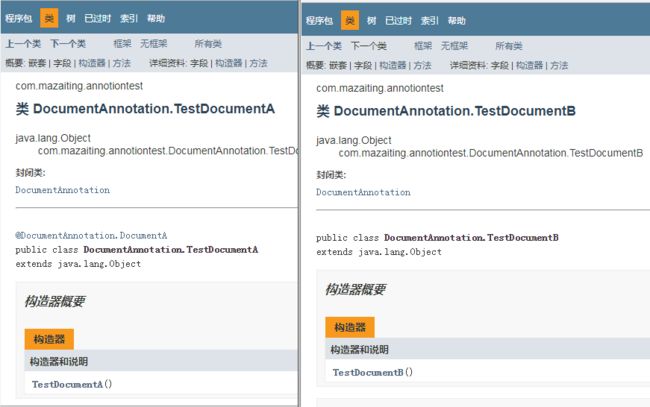- J2SE5.0版本在 java.lang.annotation提供了四种元注解,专门注解其他的注解:
- @Documented –注解是否将包含在JavaDoc中
- @Retention –什么时候使用该注解
- @Target –注解用于什么地方
- @Inherited – 是否允许子类继承该注解
- @Documented–一个简单的Annotations标记注解,表示是否将注解信息添加在java文档中。
/**
* 元注解被@Documented修饰,表示它本身也会被文档化。@Retention元注解的值
* RetentionPolicy.RUNTIME表示@Documented这个注解能保留到运行时
* @Target元注解的值ElementType.ANNOTATION_TYPE表示@Documented这个注解只能够用来描述注解类型。
*/
@Documented
@Retention(RetentionPolicy.RUNTIME)
@Target(ElementType.ANNOTATION_TYPE)
public @interface Documented {
}
示例:
/**
* @author mazaiting
*/
public class DocumentAnnotation {
@Documented
@Retention(RetentionPolicy.RUNTIME)
@Target(ElementType.TYPE)
public @interface DocumentA{
}
@Retention(RetentionPolicy.RUNTIME)
@Target(ElementType.TYPE)
public @interface DocumentB{
}
@DocumentA
public class TestDocumentA{
public void a(){
}
}
@DocumentB
public class TestDocumentB{
public void b(){
}
}
}
使用命令生成JavaDoc文档。
javadoc xxx.java
效果图如下:
- @Retention– 定义该注解的生命周期。
@Retention(RetentionPolicy.RUNTIME)
public @interface Developer {
String value();
}
RetentionPolicy.SOURCE – 在编译阶段丢弃。这些注解在编译结束之后就不再有任何意义,所以它们不会写入字节码。@Override, @SuppressWarnings都属于这类注解。
RetentionPolicy.CLASS – 在类加载的时候丢弃。在字节码文件的处理中有用。注解默认使用这种方式。
RetentionPolicy.RUNTIME– 始终不会丢弃,运行期也保留该注解,因此可以使用反射机制读取该注解的信息。我们自定义的注解通常使用这种方式。
- @Target – 表示该注解用于什么地方。如果不明确指出,该注解可以放在任何地方。以下是一些可用的参数。需要说明的是:属性的注解是兼容的,如果你想给7个属性都添加注解,仅仅排除一个属性,那么你需要在定义target包含所有的属性。
ElementType是一个枚举类型,它可以取以下值:
TYPE:表示可以用来注解类、接口、注解类型或枚举类型;
PACKAGE:可以用来注解包;
PARAMETER:可以用来注解参数;
ANNOTATION_TYPE:可以用来注解 注解类型;
METHOD:可以用来注解方法;
FIELD:可以用来注解属性(包括枚举常量);
CONSTRUCTOR:可以用来注解构造器;
LOCAL_VARIABLE:可用来注解局部变量。
@Documented
@Retention(RetentionPolicy.RUNTIME)
@Target(ElementType.ANNOTATION_TYPE)
public @interface Target {
ElementType[] value();
}
- @Inherited – 定义该注释和子类的关系
表明被修饰的注解类型是自动继承的。具体解释如下:若一个注解类型被Inherited元注解所修饰,则当用户在一个类声明中查询该注解类型时,若发现这个类声明中不包含这个注解类型,则会自动在这个类的父类中查询相应的注解类型,这个过程会被重复,直到该注解类型被找到或是查找完了Object类还未找到。
@Documented
@Retention(RetentionPolicy.RUNTIME)
@Target(ElementType.ANNOTATION_TYPE)
public @interface Inherited {
}
如果注解中只有一个属性,可以直接命名为“value”,使用时无需再标明属性名。
示例:
可以让注解被继承,但这并不是真的继承,只是通过使用@Inherited,可以让子类Class对象使用getAnnotations()获取父类被@Inherited修饰的注解
public class InheritedAnnotation {
@Inherited
@Target(ElementType.TYPE)
@Retention(RetentionPolicy.RUNTIME)
public @interface DocumentA {
}
@Target(ElementType.TYPE)
@Retention(RetentionPolicy.RUNTIME)
public @interface DocumentB {
}
@InheritedAnnotation.DocumentA
class A{}
class B extends A{}
@InheritedAnnotation.DocumentB
class C{}
class D extends C{}
public void main(){
A a = new B();
System.out.println("已使用的@Inherited注解:"+ Arrays.toString(a.getClass().getAnnotations()));
C c = new D();
System.out.println("没有使用的@Inherited注解:"+Arrays.toString(c.getClass().getAnnotations()));
}
}
- 自定义注解
@Documented
@Retention(RetentionPolicy.CLASS)
@Target(ElementType.METHOD)
@Inherited
public @interface MethodInfo {
/**
* 在自定义注解时,有以下几点需要我们了解:
* 1. 注解类型是通过"@interface"关键字定义的;
* 2. 在"注解体"中,所有的方法均没有方法体且只允许public和abstract这两种
* 修饰符号(不加修饰符缺省为public),注解方法不允许有throws子句;
* 3. 注解方法的返回值只能为以下几种:原始数据类型), String, Class, 枚举类型,
* 注解和它们的一维数组,可以为方法指定默认返回值。
*/
String author() default "mazaiting";
String date();
int version() default 1;
}
public class Client {
public static void main(String[] args) {
exec();
exec1();
}
@MethodInfo(date = "2017.8.29" )
private static void exec() {
System.out.println("exec");
}
@MethodInfo(author = "zaitingma",date = "2017.8.29",version=2)
private static void exec1() {
System.out.println("exec1");
}
}
此时的注解还未曾起任何作用,接下来进行注解解析,解析后,注解就会起相应的作用。
- 注解的解析--编译时解析/运行时解析
编译时解析
编译时注解指的是@Retention的值为CLASS的注解,对于这类注解的解析,我们只需做以下两件事:
自定义类继承 AbstractProcessor类;
重写其中的 process 函数。
编译器在编译时会自动查找所有继承自 AbstractProcessor 的类,然后调用他们的 process 方法。
1. 新建注解类
@Target({ ElementType.FIELD, ElementType.TYPE })
@Retention(RetentionPolicy.CLASS)
public @interface Seriable {
}
2. 新建BeanProcessor继承自AbstractProcessor类,类上必须加上注解@SupportedAnnotationTypes,括号中的字符串为新注解的包名+类名。
@SupportedAnnotationTypes("com.mazaiting.Seriable")
@SupportedSourceVersion(SourceVersion.RELEASE_8)
public class BeanProcessor extends AbstractProcessor {
@Override
public boolean process(Set annotations, RoundEnvironment roundEnv) {
try {
File file = new File("F:\\test.txt");
FileOutputStream fos = new FileOutputStream(file);
fos.write("wohenhao".getBytes());
fos.close();
} catch (Exception e) {
e.printStackTrace();
}
return true;
}
}
在工程目录下新建resources/META-INF/services,然后新建文件javax.annotation.processing.Processor,里面写入BeanProcessor类的全路径名。如图2.
3. 导出为jar包
右键工程->export->JAR file->finish.
4. 新建测试工程
将上一步导出的jar包引入新工程,新建主类
public class Client {
@Seriable
String cString;
public static void main(String[] args) {
System.out.println(1);
}
}
5. 开启Factory Path
右键工程->Java Compiler->Annotation Processing->Factory Path->Add JARs,选择刚刚导入的jar包,点击OK。
6. 右键运行项目,在F盘下即可看到test.txt文件。
运行时解析
1. 新建注解
@Documented
@Target(ElementType.METHOD)
@Inherited
@Retention(RetentionPolicy.RUNTIME)
public @interface AuthorAnno {
String name();
String website() default "mazaiting";
int version() default 1;
}
2. 创建主类,主类中
public class AuthorAnnoDemo {
@AuthorAnno(name="mazaiting",website="[email protected]",version=1)
public static void main(String[] args) throws SecurityException, ClassNotFoundException {
// 使用反射来解析注解
Parse.parse(AuthorAnnoDemo.class);
System.out.println("main");
}
@AuthorAnno(name = "zaitingma")
public void demo() {
System.out.println("demo");
}
}
3. 编写Parse.parse(Class clazz) 方法来解析注解
public class Parse {
public static void parse(Class clazz) throws SecurityException, ClassNotFoundException {
// 获取类中的所有方法
Method[] methods = clazz.getMethods();
// 遍历方法
for (Method method : methods){
// 如果该方法的注解父类是AuthorAnno
if (method.isAnnotationPresent(AuthorAnno.class)) {
// 获取注解
AuthorAnno authorInfo = method.getAnnotation(AuthorAnno.class);
// 打印注解信息
System.out.println("method: "+ method);
System.out.println("name= "+ authorInfo.name() +
" , website= "+ authorInfo.website()
+ " , revision= "+authorInfo.version());
}
}
}
}




